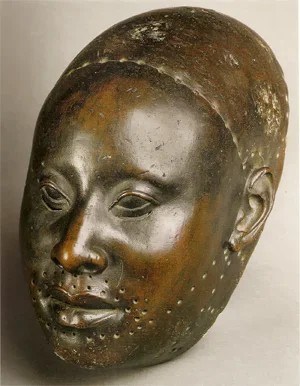
The Yoruba people (Yoruba: Àwọ̀n ọ́mọ́ Yorùbá) are an ethnic group of southwestern Nigeria and southern Benin in West Africa. The Yoruba constitute over 35 million people in total, the majority of this population is from Nigeria and make up 21% of its population, according to the CIA World Factbook, making them one of the largest ethnic groups in Africa. The majority of the Yoruba speak the Yoruba language which is a tonal Niger-Congo language. The Yoruba share borders with the Borgu in Benin; the Nupe and Ebira in central Nigeria; and the Edo, the Ẹsan, and the Afemai in mid-western Nigeria. The Igala and other related groups are found in the northeast, and the Egun, Fon, and others in the southeast Benin. The Itsekiri who live in the north-west Niger delta are related to the Yoruba but maintain a distinct cultural identity. Significant Yoruba population in West Africa can be found in Togo, Sierra Leone (where they have blended in with the Saro and Sierra Leone Creole people), and Ghana. The Yoruba diaspora consists of two main populations which includes recent migrants of which the majority moved to the United States and the United Kingdom after major economic related migrations stemming from the 1970s; the other diaspora is a much older population dating back to the Atlantic slave trade whose ancestors had arrived in the Americas through slave ships to be used as slaves and indentured servants. The former population are of Yoruba descent through their enslaved ancestors and are found in the majority in Cuba, Brazil, and Trinidad and Tobago.
Contents
Name
As an ethnic description, the word 'Yoruba' was first recorded in reference to the Oyo Empire in a treatise written by the 16th-century Songhai scholar Ahmed Baba. It was popularized by Hausa usage and ethnography written in Arabic and Ajami during the 19th century, in origin referring to the Oyo exclusively. The extension of the term to all speakers of dialects related to the language of the Oyo (in modern terminology North-West Yoruba) dates to the second half of the 19th century. It is due to the influence of Samuel Ajayi Crowther, the first Anglican bishop in Nigeria. Crowther was himself a Yoruba and compiled the first Yoruba dictionary as well as introducing a standard for Yoruba orthography. The alternative name Akú, apparently an exonym derived from the first words of Yoruba greetings (such as Ẹ kú àárọ? "good morning", Ẹ kú alẹ? "good evening") has survived in certain parts of their diaspora as a self-descriptive.
Yoruba language
The Yoruba culture was originally an oral tradition, and the majority of Yoruba people are native speakers of the Yoruba language. The number of speakers is roughly estimated at about 30 million in 2010. Yoruba is classified within the Edekiri languages, which together with the isolate Igala form the Yoruboid group of languages within the Volta-Niger branch of the Niger-Congo phylum. Igala and Yoruba have important historical and cultural relationships. The languages of the two ethnic groups bear such a close resemblance that researchers such as Forde (1951) and Westermann and Bryan (1952) regarded Igala as a dialect of Yoruba.
The Yoruboid languages are assumed to have developed out of undifferentiated Volta-Niger group by the 1st millennium BC. There are three major dialect areas: Northwest, Central, and Southeast. As the North-West Yoruba dialects show more linguistic innovation, combined with the fact that Southeast and Central Yoruba areas generally have older settlements, suggests a later date of immigration for Northwest Yoruba.
The area where North-West Yoruba (NWY) is spoken corresponds to the historical Oyo Empire. South-East Yoruba (SEY) was probably associated with the expansion of the Benin Empire after c. 1450. Central Yoruba forms a transitional area in that the lexicon has much in common with NWY, whereas it shares many ethnographical features with SEY.
Literary Yoruba, the standard variety learnt at school and that spoken by newsreaders on the radio, has its origin in the Crowther's Yoruba grammar compiled in the 1850s. Though for a large part based on the Oyo and Ibadan dialects, it incorporates several features from other dialects.
History
History of the Yoruba people
The African peoples who lived in Yorubaland, at least by the seventh century B.C.E, were not initially known as the Yoruba, although they shared a common ethnicity and language group. The historical Yoruba develop in situ, out of earlier (Mesolithic) Volta-Niger populations, by the 1st millennium B.C.E. Oral history recorded under the Oyo Empire derives the Yoruba as an ethnic group from the population of the older kingdom of Ile-Ife (see also Yoruba mythology). Archaeologically, the settlement at Ife can be dated to the 4th century B.C.E, with urban structures appearing in the 12th century (the urban phase of Ife before the rise of Oyo, ca. 1100-1600, is sometimes described as a "golden age" of Ife). Oyo and Ile-Ife The settlement at Ife appears to have entered a "golden age" with the appearance of urban structures by the 12th century. This seems to be the formative period of the Yoruba people as reflected in oral tradition and continues to be seen as the "spiritual homeland" of the Yoruba. Ife was surpassed by the Oyo Empire as the dominant Yoruba military and political power in the 17th century. The oba or ruler of Ife is referred to as the Ooni of Ife. The Oyo Empire was active in the African slave trade during the 18th century. The Yoruba often demanded slaves as a form of tribute of subject populations, who in turn sometimes made war on other peoples to capture the required slaves. Part of the slaves sold by the Oyo Empire entered the Atlantic slave trade. The oba or ruler of Oyo is referred to as the Alaafin of Oyo. Most of the city states were controlled by Obas (or royal sovereigns with various individual titles) and councils made up of Oloyes, recognised leaders of royal, noble and, often, even common descent, who joined them in ruling over the kingdoms through a series of guilds and cults. Different states saw differing ratios of power between the kingships and the chiefs' councils. Some such as Oyo had powerful, autocratic monarchs with almost total control, while in others such as the Ijebu city-states, the senatorial councils held more influence and the power of the ruler or Ọba, referred to as the Awujale of Ijebuland, was more limited. Yoruba settlements are often described as primarily one or more of the main social groupings called "generations"
The "first generation" includes towns and cities known as original capitals of founding Yoruba states/kingdoms.
The "second generation" consists of settlements created by conquest.
The "third generation" consists of villages and municipalities that emerged following the internecine wars of the 19th century.
Pre-colonial government of Yoruba society
Monarchies were a common form of government in Yorubaland, but they were not the only approach to government and social organization. The numerous Ijebu city-states to the west of Oyo and the Ẹgba communities, found in the forests below Ọyọ's savanna region, were notable exceptions. These independent polities often elected an Ọba, though real political, legislative, and judicial powers resided with the Ogboni, a council of notable elders. The notion of the divine king was so important to the Yoruba, that it has been part of their organization in its various forms from their antiquity to the contemporary era. During the internecine wars of the 19th century, the Ijebu forced citizens of more than 150 Ẹgba and Owu communities to migrate to the fortified city of Abeokuta. Each quarter retained its own Ogboni council of civilian leaders, along with an Olorogun, or council of military leaders, and in some cases its own elected Obas or Baales. These independent councils elected their most capable members to join a federal civilian and military council that represented the city as a whole.Commander Frederick Forbes, a representative of the British Crown writing an account of his visit to the city in the Church Military Intelligencer (1853), described Abẹokuta as having "four presidents", and the system of government as having "840 principal rulers or 'House of Lords,' 2800 secondary chiefs or 'House of Commons,' 140 principal military ones and 280 secondary ones." He described Abẹokuta and its system of government as "the most extraordinary republic in the world."
Leadership
Gerontocratic leadership councils that guarded against the monopolization of power by a monarch were a trait of the Ẹgba, according to the eminent Ọyọ historian Reverend Samuel Johnson. Such councils were also well-developed among the northern Okun groups, the eastern Ekiti, and other groups falling under the Yoruba ethnic umbrella. In Ọyọ, the most centralized of the precolonial kingdoms, the Alaafin consulted on all political decisions with the chief/prime elector or president of the House of Lords (the Basọrun) and the council of leading nobles known as the Ọyọ Mesi.
City-states
The monarchy of any city-state was usually limited to a number of royal lineages. A family could be excluded from kingship and chieftaincy if any family member, servant, or slave belonging to the family committed a crime, such as theft, fraud, murder or rape. In other city-states, the monarchy was open to the election of any free-born male citizen. In Ilesa, Ondo, Akure and other Yoruba communities, there were several, but comparatively rare, traditions of female Ọbas. The kings were traditionally almost always polygamous and often married royal family members from other domains.Ibadan, a city-state and proto-empire founded in the 18th century by a polyglot group of refugees, soldiers, and itinerant traders from Ọyọ and the other Yoruba sub-groups largely dispensed with the concept of monarchism, preferring to elect both military and civil councils from a pool of eminent citizens. The city became a military republic, with distinguished soldiers wielding political powers through their election by popular acclaim and the respect of their peers. Similar practices were adopted by the jẹsa and other groups, which saw a corresponding rise in the social influence of military adventurers and successful entrepreneurs. The Ìgbómìnà were renowned for their agricultural and hunting prowess, as well as their woodcarving, leather art, and the famous Elewe masquerade. Groups, organizations and leagues in Yorubaland Occupational guilds, social clubs, secret or initiatory societies, and religious units, commonly known as Ẹgbẹ in Yoruba, included the Parakoyi (or league of traders) and Ẹgbẹ Ọdẹ (hunter's guild), and maintained an important role in commerce, social control, and vocational education in Yoruba polities.There are also examples of other peer organizations in the region. When the Ẹgba resisted the imperial domination of the Ọyọ Empire, a figure named Lisabi is credited with either creating or reviving a covert traditional organization named Ẹgbẹ Aro. This group, originally a farmers' union, was converted to a network of secret militias throughout the Ẹgba forests, and each lodge plotted to overthrow Ọyọ's Ajeles (appointed administrators) in the late 18th century. Similarly, covert military resistance leagues like the Ekiti Parapọ and the Ogidi alliance were organized during the 19th century wars by often-decentralized communities of the Ekiti, Ijẹsa, Ìgbómìnà and Okun Yoruba in order to resist various imperial expansionist plans of Ibadan, Nupe, and the Sokoto Caliphate.
Yoruba culture
In the city-states and many of their neighbors, a reserved way of life remains, with the school of thought of their people serving as a major influence in West Africa and elsewhere. Today, most contemporary Yoruba are Christians and Muslims. Be that as it may, many of the principles of the traditional faith of their ancestors are either knowingly or unknowingly upheld by a significant proportion of the populations of Nigeria, Benin and Togo.
Traditional religion and mythology
The Yoruba faith, variously known as Aborisha, Orisha-Ifa or simply (and erroneously) Ifa, is commonly seen as one of the principal components of the syncretic pool known as the African traditional religions. It largely survived the so-called middle passage, and is seen in a variety of forms in the New World as a result. Ife bronze casting of a king dated around the 12th Century, currently in the British Museum. Orisa'nla (The great divinity) also known as Ọbatala was the arch-divinity chosen by Olodumare, the Supreme, to create solid land out of the primordial water that constituted the earth and populating the land with human beings. Ọbatala descended from heaven on a chain, carrying a small snail shell full of earth, palm kernels and a five-toed chicken. He was to empty the content of the snail shell on the water after placing some pieces of iron on it, and then to place the chicken on the earth to spread it over the primordial water.
Traditional Yoruba religion
The Yorùbá religion comprises the traditional religious and spiritual concepts and practices of the Yoruba people. Its homeland is in Southwestern Nigeria and the adjoining parts of Benin and Togo, a region that has come to be known as Yorubaland. Yorùbá religion is formed of diverse traditions and has no single founder. It has influenced or given birth to thriving ways of life such as Lucumí, Umbanda and Candomblé. Yoruba religious beliefs are part of itan, the total complex of songs, histories, stories and other cultural concepts which make up the Yorùbá society. One of the most common Yoruba traditional religious concepts has been the concept of Orisha. An Orisha (also spelled Orisa or Orixa) is a spirit or deity that reflects one of the manifestations of God in the Yoruba spiritual or religious system. This religion has found its way throughout the world and is now expressed in practices as varied as Candomblé, Lucumí/Santería, Shango in Trinidad (Trinidad Orisha), Anago and Oyotunji, as well as in some aspects of Umbanda, Winti, Obeah, Vodun and a host of others. These varieties or spiritual lineages as they are called are practiced throughout areas of Nigeria, the Republic of Benin, Togo, Brazil, Cuba, Guyana, Haiti, Jamaica, Puerto Rico, Suriname, Trinidad and Tobago, the United States, Uruguay, Argentina and Venezuela among others. As interest in African indigenous religions (spiritual systems) grows, Orisha communities and lineages can be found in parts of Europe and Asia as well. While estimates may vary, some scholars believe that there could be more than 100 million adherents of this spiritual tradition worldwide.
Mythology
Oral history of the Oyo-Yoruba recounts Odùduwà to be the Progenitor of the Yoruba and the reigning ancestor of their crowned kings.
His coming from the east, sometimes understood by some sources as the "vicinity" true East on the Cardinal points, but more likely signifying the region of Ekiti and Okun sub-communities in northeastern Yorubaland/central Nigeria. Ekiti is near the confluence of the Niger and Benue rivers, and is where the Yoruba language is presumed to have separated from related ethno-linguistic groups like Igala, Igbo, and Edo. After the death of Oduduwa, there was a dispersal of his children from Ife to found other kingdoms. Each making their mark in the subsequent urbanization and consolidation of Yoruba confederacy of kingdoms, with each kingdom tracing its origin to Ile-Ife. After the dispersal, the aborigines became difficult, and constituted a serious threat to the survival of Ife. Thought to be survivors of the old occupants of the land before the arrival of Oduduwa, these people now turned themselves into marauders. They would come to town in costumes made of raffia with terrible and fearsome appearances, and burn down houses and loot the markets. Then came Moremi on the scene; she was said to have played a significant role in the quelling of the marauders advancements. But this was at a great price; having to give up her only son Oluorogbo. The reward for her patriotism and selflessness was not to be reaped in one life time as she later passed on and was thereafter immortalized. The Edi festival celebrates this feat till date.
Philosophy
Yoruba culture consists of folk/cultural philosophy, religion and folktales. They are embodied in Ifa-Ife Divination, known as the tripartite Book of Enlightenment in Yorubaland and in Diaspora.
Yoruba cultural thought is a witness of two epochs. The first epoch is an epoch-making history in cosmogony and cosmology. This is also an epoch-making history in the oral culture during which time Oduduwa was the head, the Bringer of Light, and a prominent diviner. He pondered the visible and invisible worlds, reminiscing about cosmogony, cosmology, and the mythological creatures in the visible and invisible worlds. The second epoch is the epoch of metaphysical discourse. This commenced in the 19th century in terms of the academic prowess of Dr. Bishop Ajayi Crowther, the first African Anglican Bishop.
Although religion is often first in Yoruba culture, nonetheless, it is the thought of man that actually leads spiritual consciousness (ori) to the creation and the practice of religion. Thus thought is antecedent to religion.
Today, the academic and the nonacademic community are becoming more and more interested in Yoruba culture. Thus more and more researches are being carried out on Yoruba cultural thought, as more and more books are being written on it—embossing its mark and advancing its research amongst non-African thinkers and political scientists who are beginning to open their doors to other cultures, widening their views.
One thing to remember is that Yoruba thought is mainly narrative in form, explicating and pointing to the knowledge of things, affecting the corporeal and the spiritual universe and its wellness. Yoruba people regale in hundreds of aphorisms, folktales, and lore, and they believe that any lore that widens people's horizons and presents pabulum for thought is the beginning of a philosophy.
Yoruba music
The music of the Yoruba people of are perhaps best known for an extremely advanced drumming tradition, especially using the dundun hourglass tension drums. Yoruba folk music became perhaps the most prominent kind of West African music in Afro-Latin and Caribbean musical styles. Yorùbá music left an especially important influence on the music used in Lukumi practice and the music of Cuba
The Talking Drum.
Yorùbá music is regarded as one of the more important components of the modern Nigerian popular music scene. Although traditional Yoruba music was not influenced by foreign music the same cannot be said of modern day Yoruba music which has evolved and adapted itself through contact with foreign instruments, talents and creativity. Interpretation involves rendering African, here Yoruba, musical expression using a mixture of instruments from different horizons.
Christianity and Islam
The Yoruba are traditionally a very religious people and can be found in many types of Christian denominations. There are also a large number of them engaged in Islam and the traditional Yoruba religion. Yoruba religious practices such as the Eyo and Osun Oshogbo festivals are witnessing a resurgence in popularity in contemporary Yorubaland. They are largely seen by the adherents of the modern faiths, especially the Christians and Muslims, as cultural rather than religious events. They participate in them as a means to boost tourist industries in their local economies. There are a number of Yoruba Pastors and Church founders with large congregations, e.g. Prophet Moses Orimolade Tunolase of Eternal Sacred Order of Cherubim and Seraphim C & S, Samuel Bilehou Joseph Oshoffa of Celestial Church of Christ CCC, Joseph Ayo Babalola of Christ Apostolic Church (CAC), Pastor Enoch Adeboye of the Redeemed Christian Church of God, Pastor David Oyedepo of Living Faith Church World Wide also known as Winners Chapel, Pastor Tunde Bakare of Latter rain Assembly, Prophet T. B. Joshua of Synagogue of All Nations, William Folorunso Kumuyi of Deeper Christian Life Ministry.
Twins in Yoruba society
A pair of female ere ibeji twin figures (early 20th-century) in the permanent collection of The Children's Museum of Indianapolis.Yoruba people have the highest twinning rate in the world. The Yoruba present the highest dizygotic twinning rate in the world (4.4% of all maternities). The Yoruba have the highest rate of twinning in the world, at 45-50 twin sets (or 90-100 twins) per 1,000 live births, possibly because of high consumption of a specific type of yam containing a natural phytoestrogen which may stimulate the ovaries to release an egg from each side. Twins are very important for the Yoruba and they usually tend to give special names to each twin. The first of the twins to be born is traditionally named Taiyewo or Tayewo, which means 'the first to taste the world', this is often shortened to Taiwo, Taiye or Taye. Kehinde, or Kenny for short, is the name of the last born twin. Kehinde is sometimes also referred to as Kehindegbegbon which is short for Omokehindegbegbon and means, 'the child that came last gets the rights of the eldest'.
Benin
The Yoruba are the main group in the Benin department of Ouémé, all Subprefectures; Collines Province, all subprefectures; Plateau Province, all Subprefectures; Borgou Province, Tchaourou Subprefecture; Zou Province, Ouihni and Zogbodome Subprefecture; Donga Province, Bassila Subprefecture and Alibori, Kandi Subprefecture.
Nigeria
The Yoruba are the main ethnic group in the Nigerian federal states of Ekiti, Lagos, Ogun, Ondo, Osun, Kwara and Oyo; they also constitute a sizable proportion of Kogi and Edo south west states.
Togo
There are immigrant Yoruba settlers from Nigeria who live in Togo. Tottenham Hotspur player, Emmanuel Adebayor is an example. They can be found in the Togo department of Plateau Region, Ogou and Est-Mono prefectures; Centrale Region and
Tchamba Prefecture. The chief Yoruba cities/towns are Ilesa, Ibadan,Ilorin, Fiditi, Orile Igbon, Eko (Lagos), Oto-Awori, Ejigbo, Ijẹbu Ode, Abẹokuta, Akurẹ, Ilọrin, Ijẹbu-Igbo, Ijebu-Oru, Ijebu-Awa, Ijebu-ife, Odogbolu, Ogbomọṣọ, Ondo, Ọta, Ado-Ekiti, Ikare, Ayere, Kabba, Omuo, Omu-Aran, Egbe, Isanlu, Mopa, Aiyetoro - Gbedde, Sagamu, Iperu, Ikẹnnẹ, Ogere, Ilisan, Osogbo, Offa, Iwo, Ilesa, Ilaje, Esa-Oke, Ọyọ, Ilé-Ifẹ, Iree, Owo, Ede, Badagry, (Owu, Oyo), (Owu, Egba) (ife-olukotun), Ilaro, Oko, Esie, Ago-Iwoye, Iragbiji, Aagba, Ororuwo, Aada, Akungba and Akoko. Traditionally kingship and chieftainship were not determined by simple primogeniture, as in most monarchic systems of government. An electoral college of lineage heads was and still is usually charged with selecting a member of one of the royal families from any given realm, and the selection is then confirmed by an Ifá oracular request. The Ọbas live in palaces that are usually in the center of the town. Opposite the king's palace is the Ọja Ọba, or the king's market. These markets form an inherent part of Yoruba life. Traditionally their traders are well organized, have various guilds, officers, and an elected speaker. They also often have at least one Iyaloja, or Lady of the Market, who is expected to represent their interests in the aristocratic council of oloyes at the palace.
Cuisine
Yams are said to be one of the important food for the Yoruba. Plantain, corn, beans, meat, and fish are also chief choices. Some common Yoruba foods are iyan (pounded yam), Amala, eba, semo, fufu, Moin moin (bean cake) and akara. Soups include egusi, ewedu, okra, vegetables are also very common as part of diet. Items like rice and beans (locally called ewa) are part of the regular diet. Some dishes are also prepared for festivities and ceremonies such as Jollof rice and fried rice. Other popular dishes are Ekuru, stews, corn, cassava and flours - e.g. maize, yam, plantain and bean, eggs, chicken, beef and assorted forms of meat (pumo is made from cow skin). Some less well known meals and many miscellaneous staples are arrowroot gruel, sweetmeats, fritters and coconut concoctions; and some breads - yeast bread, rock buns, and palm wine bread to name a few.
Yoruba cultural dishes
The language spread of Kru, Igbo and Yoruba in the United States according to US Census 2000
© Wikipedia
































